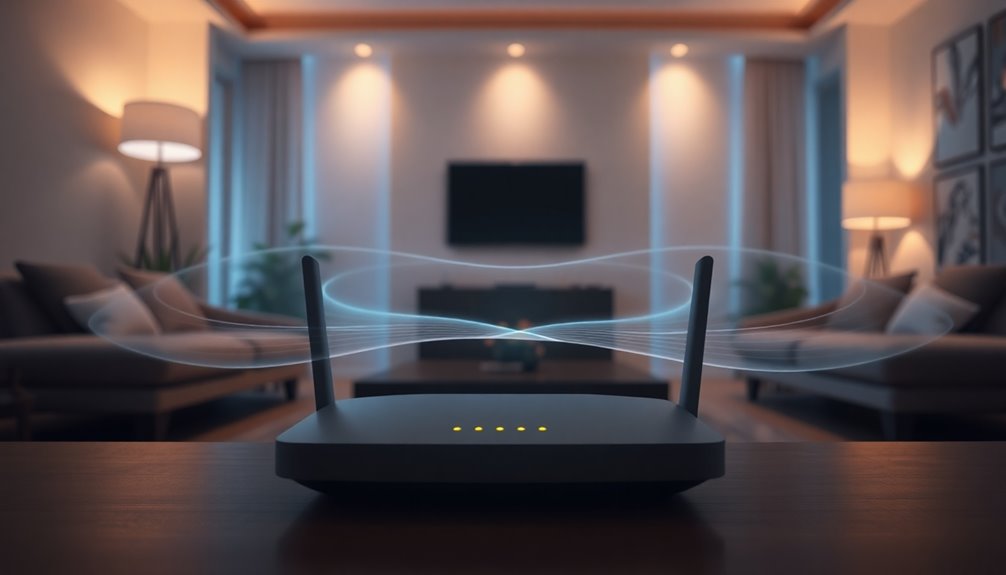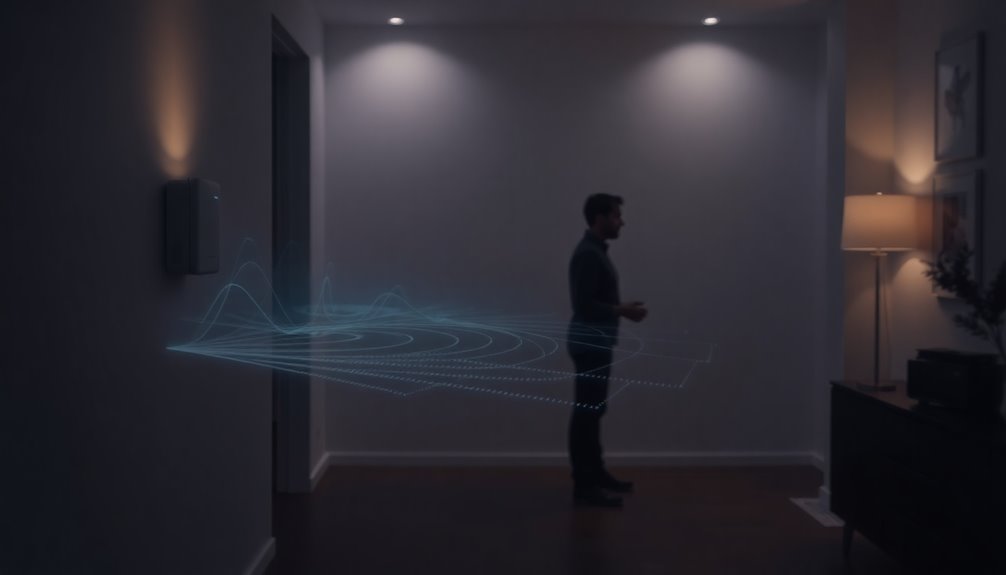Wi-Fi sensing uses existing wireless signals to detect motion without cameras, making it a privacy-friendly and cost-effective solution. By analyzing Channel State Information (CSI), you can identify changes caused by movement, gestures, or presence behind walls. Different frequencies offer various detection ranges and resolutions, suitable for smart homes or security systems. If you’re curious about how this technology works and its advantages, there’s more to explore about how Wi-Fi can transform motion detection without cameras.
Key Takeaways
- Wi-Fi sensing uses Channel State Information (CSI) to detect environmental changes caused by movement without cameras.
- Variations in Wi-Fi signals’ amplitude, phase, and frequency indicate motion or presence behind obstacles.
- Advanced signal processing and AI analyze CSI data for accurate, privacy-preserving motion detection.
- Wi-Fi’s ability to penetrate walls enables monitoring in hidden or hard-to-reach areas without visual cameras.
- Industry standards like IEEE 802.11bf enhance Wi-Fi sensing capabilities for real-time, camera-free motion detection.
Understanding Wi-Fi Sensing Fundamentals

Have you ever wondered how Wi-Fi signals can do more than just connect devices? It’s because of Channel State Information (CSI). CSI provides detailed amplitude and phase shift data for each subcarrier in WLAN signals, which is crucial for sensing. Modern Wi-Fi protocols like IEEE 802.11n and 802.11ac include CSI data that can reveal environmental changes. When obstacles or motion occur, CSI measurements reflect those disturbances, allowing you to detect patterns over time and space. This enables passive environmental awareness without extra sensors. By analyzing how Wi-Fi signals are affected, CSI helps identify movement and environmental shifts. Essentially, Wi-Fi signals become a tool for sensing your surroundings, turning everyday communication into a powerful sensing mechanism. Additionally, advancements in wireless technology have continuously improved the sensitivity and accuracy of Wi-Fi-based sensing systems.
How Wi-Fi Signals Detect Movement

Wi-Fi signals detect movement by analyzing how objects or humans disrupt the signals traveling between devices. When someone moves, it changes how signals reflect, scatter, and refract within a space, creating a complex multipath environment. These alterations affect signal characteristics like amplitude, phase, and frequency response over time. Low-frequency signals can penetrate walls and bounce inside rooms, allowing detection even behind obstacles. Advanced algorithms process these signal variations, identifying patterns associated with different types of motion or presence. They distinguish static objects from moving targets by analyzing the temporal changes in signals. This method leverages existing Wi-Fi infrastructure, making it a passive, silent process that doesn’t interfere with network performance. Additionally, the use of signal processing techniques improves detection accuracy and reduces false alarms, enhancing the system’s reliability. Moreover, ongoing research into AI-driven analysis continues to refine detection capabilities, making these systems more adaptable to various environments. Understanding the multipath environment helps optimize detection strategies and minimize errors, ultimately improving system performance. Incorporating mindfulness practices can help operators maintain focus and reduce fatigue when monitoring sensitive detection systems, ensuring consistent accuracy. Recognizing the importance of secure data management is essential to prevent unauthorized access to sensitive movement data. As a result, movement detection becomes seamless, covert, and highly effective.
The Role of Channel State Information (CSI)

Channel State Information (CSI) offers detailed insights into how wireless signals propagate through an environment by measuring variations at the subcarrier level. You can access CSI via standard Wi-Fi network interfaces, which capture how signals are affected by the environment, including multipath reflections and scattering. This information encodes the geometric properties of the surroundings, enabling sensing algorithms to map spatial features. Two primary models—ray-tracing and scattering—help interpret CSI data, focusing on direct paths or reflections. When motion occurs, it disrupts the wireless channel, causing changes in amplitude, phase, and frequency responses that CSI detects. By analyzing these variations, you can identify different types of movement, such as walking or gestures, making CSI an essential tool for passive, camera-free sensing applications. Understanding environmental effects enhances the accuracy of motion detection by accounting for static obstacles and background reflections. Additionally, advancements in wireless sensing techniques are expanding the capabilities and reliability of CSI-based motion detection systems.
Frequencies and Their Impact on Sensing Capabilities

The frequency at which Wi-Fi signals operate substantially influences their sensing capabilities. Lower frequencies, like 2.4 GHz and 5 GHz, offer longer range and better penetration through walls, making them ideal for detecting movement across larger areas and non-line-of-sight scenarios. Higher frequencies, such as 45 GHz and above, provide better resolution to detect micro-movements like breathing or heartbeat but have limited range and penetration. The 60 GHz band offers ultra-high resolution but short-range sensing, useful for detailed, localized detection. Additionally, bandwidth plays a role: wider channels, as used in Wi-Fi 6, improve sensitivity and resolution, enabling finer motion detection. Your choice of frequency determines the balance between range, penetration, and the ability to detect subtle or rapid movements. Regulatory standards also influence the available frequency bands and the technology’s deployment. The interplay between frequency and bandwidth further impacts sensing performance by affecting signal clarity and data transmission rates. Moreover, advancements in aura technology are exploring ways to enhance sensing accuracy and application versatility through optimized frequency utilization.
Practical Applications in Smart Homes and Buildings

Have you ever considered how your home can become smarter without relying on cameras or invasive sensors? Wi-Fi sensing makes this possible by detecting motion through Wi-Fi signals, offering a privacy-friendly security solution. You can receive real-time alerts on your phone when movement occurs near entrances or key areas, and systems can trigger alarms or smart devices to deter intruders. It also enhances energy management by automating lighting and climate controls based on occupancy, saving energy and reducing waste. Additionally, Wi-Fi sensing supports health monitoring by tracking movement patterns, which is useful for elder care or health assessments. This technology can also help in supporting emotional well-being by providing reassurance through consistent monitoring. Moreover, the privacy-friendly nature of Wi-Fi sensing makes it an attractive alternative to traditional security systems. User convenience improves with features like device wake-up, auto-locking, and gesture control, creating a seamless, camera-free smart home experience. The advanced technology behind Wi-Fi sensing leverages existing Wi-Fi infrastructure, making it cost-effective and easy to implement without additional hardware. As smart home technology continues to evolve, integrating Wi-Fi sensing can contribute to creating more connected and intelligent living environments.
Benefits Over Traditional Camera-Based Systems

Wi-Fi sensing offers significant advantages over traditional camera-based security systems by prioritizing privacy and non-intrusiveness. Since it detects motion through Wi-Fi signals without capturing images or videos, it addresses privacy concerns and is suitable for sensitive areas like bedrooms or bathrooms. You won’t need to worry about legal or ethical issues linked to visual surveillance. Wi-Fi signals penetrate walls and floors, providing coverage beyond line-of-sight and eliminating blind spots. This makes monitoring seamless across multiple rooms or floors without extra hardware. Additionally, it’s cost-effective, leveraging existing Wi-Fi infrastructure and requiring minimal setup. Unlike cameras, Wi-Fi sensing isn’t affected by lighting or environmental conditions, reducing false alarms and increasing reliability. It’s a scalable, real-time solution that enhances security while respecting privacy. Incorporating sustainable technology principles can further reduce environmental impact while maintaining effective monitoring. Integrating wall organization systems can also optimize the placement of Wi-Fi sensors for more comprehensive coverage.
Industry Standards Shaping the Future of Wi-Fi Sensing

Industry standards are shaping the future of Wi-Fi sensing by establishing common technical frameworks that guarantee interoperability and reliability. The IEEE 802.11bf standard focuses on enhancing the MAC and PHY layers, allowing devices to better sense motion and environment changes. These improvements optimize channel access and improve CSI measurement accuracy, ensuring consistent performance across devices. Furthermore, continuous learning models that adapt to environmental variations are integral to maintaining robust Wi-Fi sensing capabilities. The IEEE 802.11bf task group drafts these amendments, with input from organizations like the Wireless Broadband Alliance and industry leaders such as Cognitive Systems. Their collaborative efforts promote scalable, effective standards that adapt to technological advancements. As a result, Wi-Fi networks can become more interactive and automated, enabling new applications across industries. These standards lay the foundation for widespread adoption, ensuring that Wi-Fi sensing remains reliable, secure, and future-proof. Standardization efforts are critical to ensuring consistent implementation and broad compatibility of these emerging technologies, fostering technological innovation in wireless sensing. Additionally, establishing industry-wide protocols ensures seamless integration and adoption across diverse device ecosystems. Recognizing the importance of interoperability, ongoing collaboration among industry stakeholders ensures that these standards evolve in tandem with technological progress.
Leading Technologies and Innovative Solutions

Leading technologies in Wi-Fi sensing harness the power of advanced signal analysis and innovative hardware solutions to deliver accurate, real-time motion detection. By analyzing disruptions in Wi-Fi signals through Channel State Information (CSI), you can detect movement without cameras or physical sensors. AI-enhanced platforms transform these signals into motion networks, providing instant alerts and detailed historical data. These solutions are non-intrusive, privacy-preserving, and effective even in low-light or no-light environments, with no line-of-sight needed. They easily integrate with existing networks and third-party systems, supporting various protocols and operating systems. Innovations like Cognitive Systems’ WiFi Motion software lead the market by offering detailed motion insights and customizable notifications, all while utilizing your current Wi-Fi infrastructure. Additionally, understanding the support hours for various entertainment venues can help optimize your visit planning and ensure you make the most of your time.
The Future of Privacy-Preserving Motion Detection

As technology advances, privacy-preserving motion detection is poised to become an essential component of smart environments. You’ll benefit from non-intrusive monitoring that uses existing Wi-Fi infrastructure, eliminating the need for extra hardware. This approach protects privacy by avoiding cameras and audio recordings, making it suitable for sensitive settings. It’s cost-effective, leveraging current devices, and scalable, allowing easy expansion with more Wi-Fi points. Applications include home security, energy management, health monitoring, and smart building automation. Future improvements will focus on enhancing accuracy through advanced signal processing, machine learning, and deep learning techniques. As adoption grows, privacy-preserving Wi-Fi sensing will release new possibilities in autonomous vehicles, smart cities, and IoT integration, creating smarter, more private spaces for everyone.
Frequently Asked Questions
How Accurate Is Wi-Fi Sensing Compared to Camera-Based Motion Detection?
You’re wondering about the accuracy of Wi-Fi sensing compared to camera-based motion detection. Wi-Fi sensing isn’t as detailed as cameras but offers reliable tracking with a median error of less than 12 cm. It can detect multiple motions simultaneously and reduces false alarms thanks to AI. While cameras provide high-resolution visuals, Wi-Fi sensing excels in coverage, privacy, and operation in low-light conditions, making it a practical alternative for many applications.
Can Wi-Fi Sensing Differentiate Between Humans and Pets?
You might wonder if Wi-Fi sensing can reliably tell humans from pets. The answer is yes—you can achieve 95% to over 97% accuracy, even through walls. The system analyzes heartbeat, respiration, size, and movement patterns, making it effective in complex environments. With advanced features like real-time detection and low false alarms, Wi-Fi sensing offers a privacy-preserving, cost-effective way to distinguish humans from pets without cameras.
What Are the Limitations of Wi-Fi Sensing in Complex Environments?
In complex environments, you face limitations with Wi-Fi sensing like multipath propagation and signal occlusion, which can cause false positives or missed detections. Interference from other devices and environmental clutter disrupt signal stability, making it hard to accurately track movement. You also need to contend with hardware differences and the limited resolution of sub-6 GHz bands, which reduce detection accuracy, especially in crowded or obstacle-rich settings.
How Does Wi-Fi Sensing Handle Multiple Moving Objects Simultaneously?
Imagine a busy room where multiple objects move freely—Wi-Fi sensing captures this chaos seamlessly. You use CSI to detect each motion, even behind walls or obstacles. The system processes signals in real-time, distinguishing walking, running, or gestures. With multiple access points working together, it provides an accurate, privacy-friendly picture of the environment. You get instant, reliable detection, making it ideal for security, health, or industrial needs without needing cameras.
Is Wi-Fi Sensing Effective Through Walls or Multiple Rooms?
You wonder if Wi-Fi sensing works through walls or multiple rooms. It can, but effectiveness depends on wall material, thickness, and signal strength. Hollow walls allow better detection, while concrete walls attenuate signals more. Although recent advances improve imaging and gesture decoding, multi-room sensing remains challenging. Keep in mind, privacy concerns grow as this technology gets better at penetrating walls, raising ethical questions about surveillance and consent.
Conclusion
Imagine a smart home that detects your movement without cameras, ensuring privacy while maintaining security. Wi-Fi sensing makes this possible by using existing signals to monitor motion discreetly. As industries adopt this technology, you’ll see it transform how we manage buildings and protect privacy. For example, a hospital could use Wi-Fi sensing to track patient activity without invasive cameras. Embrace this innovative, privacy-friendly future—it’s changing the way we sense and secure our spaces.









